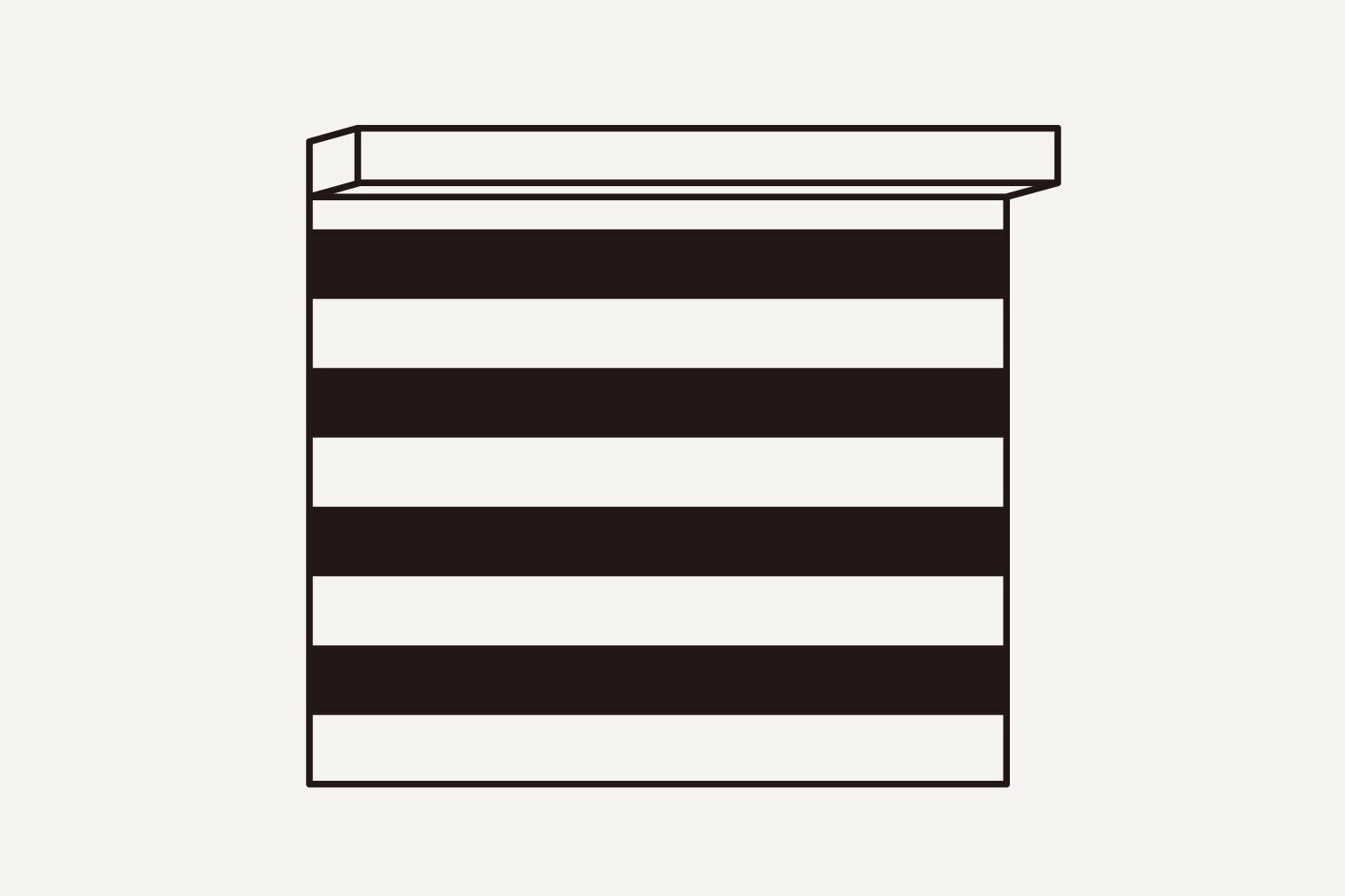What are Zebra Shades
Zebra Shades, also known as zebra blinds, dual shades, or layered shades, are a type of window treatment that combines the features of both roller shades and traditional blinds. They are made from a continuous loop of fabric featuring alternating horizontal bands of sheer and solid material. This design offers an additional method for controlling light beyond simply raising or lowering the shades. When you adjust the zebra shade blinds, the solid bands can either align with the sheer bands to block light and provide privacy or overlap each other to allow light through and provide a view outside. This dual functionality provides you with precise control over both light and privacy. Here is a structure diagram of zebra shades:

- Mounting Brackets: These are hardware components used to attach the zebra shade to the wall, ceiling, or window frame.
- Valance: The valance is a decorative cover that conceals the top mechanism of zebra window shades and secures the fabric edges, completing the dual-fabric design.
- Tube: This is a cylindrical component located at the top of zebra window blinds, around which the fabric is wrapped to facilitate the rolling mechanism, allowing the fabric to move up and down.
- Fabric: This is the core material of the zebra shades, featuring alternating bands of sheer and solid fabric, commonly referred to as opaque and sheer stripes or dark and light stripes.
- Bottom Tube / Bottom Hollow Rod: It helps the fabric to roll evenly when pulled, ensuring that the fabric does not wrinkle or deform during the raising and lowering process.
- Bottom Rail: The bottom rail serves as a counterweight that ensures the fabric hangs straight and evenly.
- Handle: The handle is used to manually adjust the height of window zebra shades.
How are Zebra Shades Made
Zebra shades are meticulously crafted through a detailed manufacturing process that includes several key components: the valance, fabric, tube, bottom rail, and handle.
Valance

Valance, or cassette, is a decorative accessory that covers the top mechanism of zebra shades for windows, where the fabric is attached and the rolling mechanism is housed. It serves both aesthetic and functional purposes. Typically made from aluminum alloy, valances come in either square or curved shapes. The production process for aluminum alloy valances involves several key steps:
- Material Selection: High-quality aluminum alloy is chosen for its durability, lightweight nature, and resistance to corrosion. This ensures that the valances can withstand daily use while retaining their appearance over time.
- Extrusion: The aluminum is then extruded into the desired shapes — either square or curved. This process involves pushing the material through a mold to create long profiles that can be cut to specific lengths.
- Cutting and Finishing: Once extruded, the profiles are cut to size based on the specifications for the zebra blinds. The edges are smoothed to prevent sharp corners, ensuring safety and a polished look.
- Surface Treatment: To enhance durability and aesthetics, the valances undergo surface treatment. This may include anodizing or powder coating, which not only adds color but also protects the aluminum from scratches and environmental damage.
Another popular style of valance is the cassette with a fabric insert. In this design, the valance is usually made of aluminum, following the same production steps outlined above. However, the front of the valance is covered with a piece of fabric that matches the material and color of the shades. Double-sided tape, hot glue, or other adhesives secure the fabric in place. In some designs, a layer of plastic sheet is applied over the secured fabric to enhance durability and protect it. This plastic sheet is secured using methods like capping or slot designs.
Fabric

- Plain Weave: This method uses basic plain weaving techniques to interlace dark and light yarns alternately. By setting the arrangement order of each yarn, a clear striped pattern can be achieved.
- Twill Weave: This technique involves using twill weaving to arrange different yarns in an overlapping pattern, creating stripes with a certain diagonal slant. This approach adds depth and texture to the fabric.
- Jacquard Weave: Utilizing a Jacquard loom allows for the creation of complex patterns and stripes within the fabric. By controlling the placement of different colored yarns during the weaving process, rich visual effects can be achieved.
During the weaving process, different colored yarns are alternated as warp and weft threads, creating stripes through their intersection. The loom must accurately control the width and spacing of each colored yarn to produce a consistent pattern of sheer and opaque stripes. This spacing is determined by the design requirements to achieve specific light-blocking effects. By adjusting the density of the warp and weft, we can define the sections of sheer and opaque stripes. Densely woven areas create opaque stripes that block light, while more open or mesh-like sections form sheer stripes that allow light to pass through.
Tube and Bottom Rail


The tube is the roller mechanism at the top that allows the fabric to roll up or down around a cylinder, while the bottom rail is a weighted bar ensuring the fabric hangs straight and taut for stability and smooth operation. Typically, both parts are made from the same material and use similar manufacturing processes. These materials often include aluminum, steel, or durable plastics.
1.Aluminum
As a metal known for its lightweight nature, durability, strength, aesthetic versatility, and cost-effectiveness, aluminum is an excellent choice for constructing both the tube and bottom rail in zebra window blinds. The manufacturing process typically involves several key steps:
- Extrusion: The process begins with aluminum rods or sheets being shaped through an extrusion machine. This technique allows the material to be formed into specific dimensions and contours, tailored to fit the design requirements of the zebra blinds.
- Cutting and Calibration: Once extruded, the aluminum profiles are cut to the required lengths. This step includes calibration to ensure that the tubes and rails are straight and meet the precise specifications needed for assembly.
- Surface Treatment: To enhance both aesthetic appeal and durability, surface treatments such as anodizing or spraying are applied. Anodizing increases corrosion resistance, while various coatings can improve the visual attractiveness of the bottom rail.
2.Steel
Steel is another common material for the tube and bottom rail of zebra blinds, offering exceptional strength and durability. The roller tube is usually made of cold-rolled steel or galvanized steel, while the bottom rail is typically made of stainless steel. The manufacturing process involves the following steps:
- Cutting: Steel is cut according to design specifications to achieve the appropriate lengths and shapes for the bottom rail.
- Mechanical Shaping: The cut steel undergoes processes such as bending, cold rolling, and welding to achieve the desired shape and structural integrity.
- Surface Treatment: The bottom rail undergoes polishing, brushing, or passivation to improve its surface finish and corrosion resistance, while the roller tube is galvanized, painted, or treated in other ways to enhance its anti-corrosion properties.
3.PVC
PVC is occasionally used in the roll tube and bottom rail of zebra blinds, valued for its lightweight and versatile properties. The manufacturing process for PVC includes:
- Extrusion Molding: PVC material is heated until it becomes molten, then extruded into tubular shapes tailored for the roll tube and bottom rail.
- Cooling and Stabilization: After extrusion, the tubes are rapidly cooled using water or air cooling systems to solidify them into their final shape.
- Cutting and Processing: The PVC tubes and rails are cut to specified lengths and may undergo additional processing to ensure they meet installation requirements.
- Surface Treatment: Finally, surface treatments such as sanding or coating are applied to improve the visual appearance and tactile quality.
4. Iron
Iron is sometimes utilized for the bottom rail, particularly in more traditional designs. The manufacturing process for iron rails includes the following steps:
- Cutting: Iron materials are cut to the required lengths using cutting machines to ensure precision.
- Mechanical Shaping: The cut iron is processed through bending, stamping, or other mechanical methods to achieve the desired shape for the bottom rail.
- Welding: If the design requires joining multiple segments, welding is performed to create a robust and secure connection.
- Surface Treatment: To prevent rust and enhance durability, surface treatments such as rust removal through acid pickling or sandblasting are employed, followed by galvanization or spraying. High-end finishes may also include sealing processes to further improve corrosion resistance.
Handle

Handle is a component centrally located on the bottom rail, allowing users to easily pull or adjust the blinds. Designed with an ergonomic shape, it fits comfortably in the hand, making operation effortless—even during extended use. Typically made of lightweight plastic, the handle combines durability with user-friendly design. The production process generally involves several key steps:
- Drying Treatment: Initially, the plastic undergoes a drying process to remove moisture content, which helps prevent the formation of bubbles or defects during the molding stage.
- Injection Molding: Once dried, the plastic pellets are fed into an injection molding machine. Here, the pellets are heated until they melt, and the molten plastic is injected into a mold, where it cools and solidifies into the desired handle shape.
- Trimming: After the handles are removed from the molds, they undergo a trimming process to eliminate any excess flash or burrs, ensuring a smooth and refined finish.
- Surface Treatment: Finally, surface treatments such as spraying, printing, or screen printing are applied to enhance the aesthetic appeal, making the handles both attractive and user-friendly.
How do Cordless Zebra Shades Work
Due to a new safety standard effective June 1, 2024, most window coverings in the U.S. will be either cordless or have inaccessible cords. This change brings up questions about the operation of cordless zebra shades. Without pull cords, are they less convenient? On the contrary, cordless zebra blinds not only enhance safety but also ensure easy operation.
Manual Zebra Shades
Manual zebra shades, also known as hand-held zebra shades, are adjusted by manually pulling the handle or bottom rail to raise or lower them. These cordless shades can be stopped at any desired height thanks to a dynamic balance between the spring tension and the weight of the shades. Typically, two types of springs are used in the operation mechanism of cordless zebra blinds: tension springs and spiral springs.
Tension Spring-Based System

The main component of this system is a spring rod. When the fabric isn't pulled down, the spring remains in a pre-tensioned state. As the fabric is lowered, the spring twists with the roll tube, increasing tension. When the fabric is stopped, the spring's tension balances the weight of the zebra shade along with resistance from a friction mechanism, keeping the fabric stable—preventing it from sliding down due to gravity or bouncing back from the spring force. The spring’s elasticity also helps control the fabric's descent speed, preventing it from dropping suddenly. When the zebra blinds are pulled upwards, the spring loosens as it rotates with the roll tube, releasing its tension and working with the user's force to lift the fabric. When stopped at a certain height, the spring remains compressed, with its tension counteracting the shade's weight, and the friction mechanism providing additional resistance to maintain stability.
Spiral Spring-Based System

This system operates similarly to the tension spring system but uses a different device. The spiral spring is also pre-tensioned initially, storing energy, meaning it always provides tension when no external force is applied. As the fabric is pulled down, the spiral spring compresses, storing more energy. During descent, the internal friction mechanism ensures a controlled, smooth lowering speed, preventing rapid falls. When pulling the fabric upwards, the spiral spring releases stored energy, assisting in a smooth rise. Once stopped at any height, the spiral spring's tension counteracts most of the zebra blind's gravitational pull, while the friction mechanism applies resistance to keep the fabric stable.
In summary, the ability of cordless zebra shades to stay in place at any position relies on the dynamic balance between the spring tension, the zebra shade's weight, and the friction mechanism's resistance. The specific type of spring and device details may vary depending on the manufacturer's design.
Motorized Zebra Shades

Motorized zebra shades are powered by motors and can be controlled via remote control, smartphone apps, or home automation systems, eliminating the need for manual operation. These zebra shades typically use small cylindrical motors, which are convenient for installation as they can be hidden inside the roll tube without affecting the overall appearance and functionality of the shade. The motor is usually connected to a set of gears and a reel; upon receiving a signal, the motor rotates the reel, driving a winding or roller mechanism to roll down and up the fabric.
Motorized zebra blinds utilize various types of motors, including AC motors, DC motors, and lithium battery motors, each offering distinct power supply methods suited to different home environments.
- AC Motors: These motors are powered by household AC power and are best for installations near electrical outlets. They provide continuous power, making them ideal for frequent and extended use.
- DC Motors: Powered by low-voltage DC sources, such as batteries or external DC adapters, these motors are perfect for wireless installations where access to power is limited. However, their operation time depends on battery capacity, necessitating regular battery replacement or recharging.
- Lithium Battery Motors: Featuring built-in rechargeable lithium batteries, these motors can be charged via USB or a dedicated charger. They allow for versatile installation without the need for external power lines and can operate for prolonged periods after charging, though users must keep track of the charging cycle.
Control options for motorized zebra shades are diverse. They can be operated via a remote control, a wall-mounted switch, or managed through Wi-Fi, Zigbee, or Bluetooth. Control is also possible via a smartphone app or voice assistant. Remote controls are available in single-channel or multi-channel versions; a single-channel remote can control one shade, while a multi-channel remote can manage multiple shades by changing channels on the same device.
Features and Functions of Zebra Shades
Zebra blinds feature an innovative design that offers versatile functionality, allowing for precise control over light and privacy. You can easily adjust them to filter sunlight or maintain privacy to suit different activities and times of day. Available in both light filtering and blackout options, zebra shades offer a flexible window treatment solution that can be tailored to your lifestyle, whether you want a cozy, well-lit atmosphere or complete seclusion.
Light Level Adjustment
One of the standout features of window zebra shades is their remarkable ability to adjust the amount of light entering a room, much like traditional blinds. By simply overlapping the solid bands—where the dark stripes on the front overlap with the dark stripes on the back—a beautifully diffused light effect is created, gently filtering into your space and allowing for a bright and airy atmosphere. Conversely, when privacy or a darker setting is desired, you can space out the solid bands so that the dark stripes overlap the light stripes entirely, effectively blocking out more light. Additionally, zebra blinds can be fully raised or lowered, offering complete control over the light levels in your home.
Opacity
Opacity refers to the degree to which light is blocked by the zebra window blinds when the opaque stripes completely overlap the sheer stripes. Zebra shades are designed with versatility in mind, offering both light filtering and blackout options. This means you can choose how much light you want to let in, whether you prefer a softly illuminated space or a completely darkened environment for movie nights or restful sleep.
Privacy Protection
The privacy protection feature of zebra shades is ingeniously simple yet highly effective. By aligning the opaque sections of the shades, you can successfully block external views, ensuring that your private moments remain undisturbed. This is particularly advantageous for bedrooms or living spaces where the desire is to enjoy natural daylight while preserving a sense of seclusion. Typically, blackout zebra shades offer superior privacy compared to light-filtering variations, making them an excellent choice for those who prioritize both privacy and flexibility in their home environments.



Share:
The Complete Guide to Cellular Shades
The Complete Guide to Roller Shades